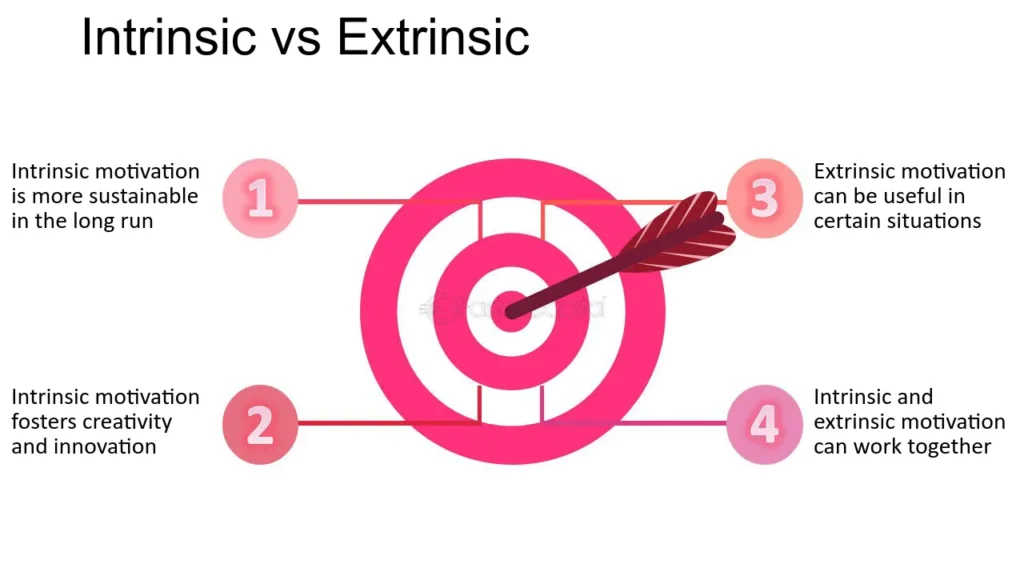Motivation is the driving force behind human behavior, steering actions, decisions, and achievements. It’s often categorized into intrinsic, extrinsic, and amotivation. But what about the oddities? Let’s delve into the intriguing realm of identifying odd things concerning different types of motivation, understanding the role of transition words, and simplifying their connection in simple tense.
Table of contents
Intrinsic Motivation: The Inner Drive
Intrinsic motivation refers to internal drives that lead individuals to engage in activities out of personal enjoyment or satisfaction. It’s that natural inclination to pursue tasks for the sheer pleasure they bring. Consider a hobby pursued solely for the joy it brings rather than for any external rewards.
In real-life scenarios, intrinsic motivation is evident in passionate pursuits such as art, hobbies, or learning for personal growth. While it fosters autonomy and creativity, it might lack external validation, posing challenges in competitive environments.

Extrinsic Motivation:
Conversely, extrinsic motivation is fueled by external rewards or pressures. It’s evident in actions driven by tangible rewards or to avoid punishment. Think about studying hard for grades or working diligently for a promotion or bonus.
While extrinsic motivation can prompt action and efficiency, it may diminish intrinsic interest and creativity. However, it plays a significant role in achieving short-term goals and meeting external expectations.
A motivation:
A motivation is the absence of motivation or a lack of intention to act. It arises when individuals perceive no connection between their actions and desired outcomes. This state can lead to disengagement, lack of effort, and demotivation.
Addressing motivation requires understanding its roots, which could stem from various factors like feeling incompetent or experiencing a lack of control.
| Aspect | Motivation | Absence of Motivation | Contributing Factors |
| Definition | The drive or desire to act and | The lack of intention or drive to act, leading to | Feeling incompetent |
| achieve a goal or outcome | disengagement and lack of effort | Lack of connection between actions and desired outcomes | |
| Causes | Positive goals, sense of | Disconnection between actions and outcomes, feeling | Lack of control |
| accomplishment, intrinsic | incompetent, lack of control over the situation, | Lack of interest or relevance in the task/goal | |
| and extrinsic rewards | absence of perceived positive outcomes from action | Overwhelm or burnout | |
| Effects | Engagement, effort, | Demotivation, disengagement, decreased productivity, | Reduced performance |
Identifying Oddities in Motivation Types
What about the odd motivations that don’t neatly fit into these categories? Sometimes, motivations might have unusual sources or combinations, leading to unexpected behaviors. Transition words, often overlooked in motivation discussions, play a crucial role in identifying these odd motivations.
Transition words like “although,” “despite,” or “however” signal shifts in motivation or conflicts between intrinsic and extrinsic drives. Recognizing these words helps uncover nuances in motivation that might not align with conventional classifications.
Simplicity in Tense and Motivation
The tense used to express motivations also holds significance. Using simple tenses in describing motivations ensures clarity and straightforwardness in understanding intentions and drives. The choice of tense impacts the interpretation of motivations, highlighting the temporal aspect of desires and actions.
Clarity through Simple Tenses:
- Simple tenses, like present simple or past simple, offer a direct and clear expression of motivations. They depict intentions without complicating them with continuous or perfect aspects, making motivations easily understandable.
Immediate Understanding:
- Using simple tenses allows motivations to be perceived as immediate or definite. For instance, “She wants” or “He wanted” express a clear desire without adding nuances that could cloud the intended message.
Temporal Focus:
- Simple tenses emphasize the temporal aspect of motivations. Present simple indicates ongoing or habitual motivations, while past simple highlights motivations in a specific time frame, aiding in understanding when and how motivations occurred.
Impact on Interpretation:
- The choice of tense influences how motivations are interpreted. Present simple suggests ongoing desires or goals, while past simple may indicate motivations that have evolved or changed over time.
Conciseness and Effectiveness:
- Simple tenses contribute to concise communication of motivations. They eliminate unnecessary details, enabling a straightforward and effective conveyance of intentions and drives.
Conclusion
Uncovering odd motivations within the spectrum of intrinsic, extrinsic, and motivation is crucial for a comprehensive understanding of human behavior. Recognizing transition words and simplifying tense aids in this exploration, enriching our comprehension of the complexities of motivation.
Readmore :Khaby : From Factory Worker to Social Media Sensation
FAQ’s
Motivations often intersect and can evolve over time, leading to shifts between categories.
Transition words signal shifts or conflicts in motivations, aiding in identifying unusual drives.
Amotivation can be transient and is often addressable through various strategies.
Yes, some motivations might have unique sources or combinations, defying traditional classifications.

